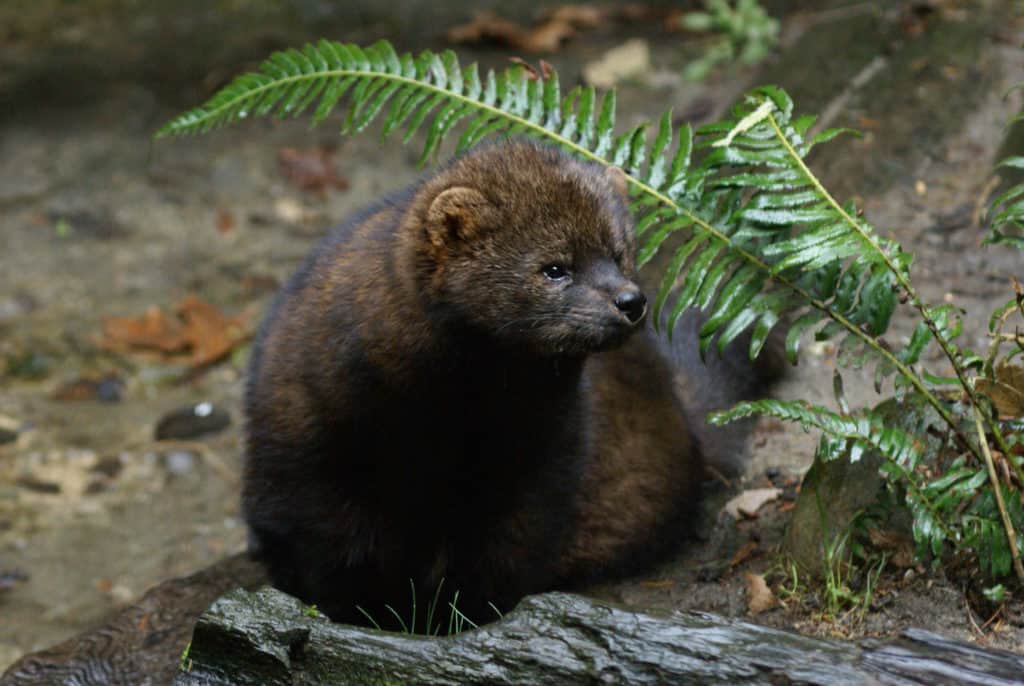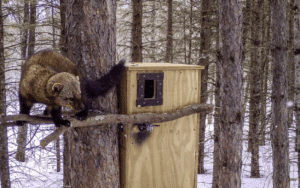
As the population of Minnesota’s fishers decline, University of Minnesota-Duluth scientists are trying to see if artificial nests can help the animals rebound. The Minnesota Department of Natural Resources estimates that the fisher population across the state has fallen from about 17,000 to 7,000 in the last 20 years.
Fishers are the largest member of the weasel family in the region, and are the only wild animal that preys on porcupines. Covered in brown fur, fishers are about the size of a house cat or red fox, with short legs and a bushy tail. They are sleek and secretive, rarely observed by most people.
The reclusive creatures generally prefer nesting in aspen trees over 20 inches in diameter. That may be why the creatures are dwindling in numbers, as such trees can be hard to find due to changing forests and forest management — representing only about two percent of northern Minnesota’s forests. It takes about 80 years for an aspen to reach 20 inches in diameter, while most aspen that is managed for paper or lumber is logged on a 40- to 60-year cycle.
A growing population of bobcats in the area, which are fishers’ only predator and also compete for prey, may also be responsible. The wild cats are fond of young aspen forests.
The issue was the subject of a recent story in the Duluth News Tribune.
Wildlife biologist Michael Joyce from the Natural Resources Research Institute is trying a new way to give fishers a boost. He and assistants are deploying 52 nest boxes across the region this fall, and will monitor them next spring to see if female fishers use them to raise young. Partner agencies are putting up more. The boxes are heavy wood, insulated, and loaded with sensors to detect nesting activity. A similar program in British Columbia saw about 30 percent den box usage.

Hoping to help
In Minnesota, the project is a trial of the idea to help fishers within the forest’s current conditions. The project was prodded by a small successful pilot last winter in Carlton County, as reported by Minnesota Conservation Volunteer. Two nest boxes placed there showed a female fisher visiting in late April. It seemed too late to be denning, but provided hope for future seasons.
The study was subsequently funded with $190,000 from the Minnesota Natural Resources Trust Fund, state proceeds from lottery ticket sales.
The question is not just whether fishers will use the boxes or not, but rather if the boxes can draw the animals into new areas they might not otherwise occupy. They will be placed both amid mature aspen forest with natural den sites, and in younger aspen forest that provides prey but no nest cavities.
“If [fishers] use them only where they already have good habitat, then it really doesn’t make any sense to add boxes,” Joyce told the News Tribune. “But if they use them in the more marginal, sub-prime habitat, where there may not be another option for them, then we might make a difference. We need to figure that out.”
DNR specialist John Erb gives reason to hope the project is targeting the biggest problem. He radio-collared female fishers and confirmed almost all nest in big trees.
“I believe that changes in the forest, mostly age, likely explain both declines up north,” Erb said.

Intersecting interests
The den boxes have found support from atypical partners. Lumber and paper company Blandin-UPM is putting up fisher boxes, and trappers have placed 1,000 boxes for fishers’ smaller cousin, the American marten, which they report are also sometimes used by fishers.
Lumber companies are keen to avoid the possibility of fishers being placed on the Endangered Species List, which could curtail the industry. Trappers are concerned about the long-term health of the population. The trapping season has been shortened and limits reduced, so the population decline is already affecting that sector. The effort to protect fishers in the Pacific Northwest has led to a major conflict between conservationists and the federal government. Fishers in California, Oregon, and Washington are all listed as imperiled at the state level, and environmental groups have been trying to get them added to the federal Endangered Species List since 2004.
The NRRI researchers are trying to balance competition for aspen trees between people and wildlife, offering an opportunity to continue logging while saving fishers from decline.
“We are definitely not anti-logging. But we are trying to see if we can strike a balance between human needs for wood products and what the animals need to survive in the woods,” Joyce told the Duluth News Tribune. “Maybe we can find some options, some tools for foresters and land managers on what they can do to keep some of the big trees standing.”
Next spring, the scientists will be eagerly watching the boxes, and many others will be waiting for word. Where female fishers decide to make their dens and raise their young could have broad implications.
More information

